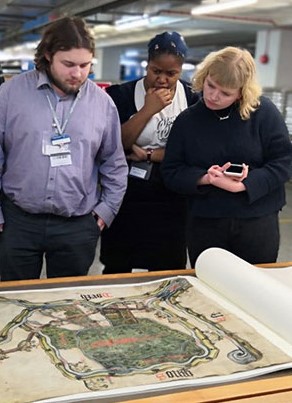Today’s documentary evidence is recorded as a series of 0s and 1s and stored on hard drives and servers. Therefore, archives need technical people and new approaches to capture and preserve these digital records today to ensure they are available in the future.
Bridging the Digital Gap, the technical traineeship programme from The National Archives, aims to bring in new people with different skills and backgrounds to create a digitally equipped and more diverse workforce. Through these traineeships, talented technical people use their skills to increase archives’ ability to retain and safeguard vital digital materials and to find new ways for others to access the history they record.

Supported by the National Lottery Heritage Fund, the programme involves three cohorts of eight trainees each. Trainees are employed by The National Archives and seconded to a host institution for their 15-month placement. Hosts include local archives and record offices, universities, and charities.
The first two cohorts of trainees worked at archives in Yorkshire, Norfolk, and London in 2018-2020. The third cohort will be based in London and the South West in 2021-2022.
While working at their host institution, trainees receive on-the-job training in standard archive practices and digital-specific areas. They are involved in digital preservation, digitisation, digital capture, cataloguing, and digital engagement.

Depending on the materials in their host archive, trainees have digitised paper-based materials, photographic prints and negatives, films, videotapes, and audiotapes. They have uploaded digital ‘surrogates’ of analogue items to their host’s online catalogue, geo-tagged images on their host’s website, and expanded information about archival films on their host’s YouTube channel.
Through their training in digital preservation, trainees have learned to ‘ingest’ digital files (text, images, audio, and video) and migrate digital collections into their host’s digital repository, usually Preservica or Archivematica. They have run regular checks to ensure the digital materials are retaining their integrity.

Some have captured emails and websites for inclusion in the digital archive. Others have made preservation copies of assets on digital media that are becoming obsolete.
Trainees have written blog posts, tweets, and Instagram stories. One devised an innovative social media campaign in which oral history recordings were linked with subtitled video clips.
During their paid placement, trainees also take part in a series of training opportunities provided by The National Archives, such as workshops, online courses, and seminars with expert speakers. Each trainee has a personal budget to spend on conferences and courses of their choice. They can also take advantage of member-only benefits from organisations to which TNA belongs, such as the Digital Preservation Coalition and the Open Preservation Foundation.

Through the programme’s partner, the Archives and Records Association (ARA), trainees receive individual membership and work toward Foundation Membership of ARA during their placement.
The Bridging the Digital Gap programme enables trainees to develop key skills that prepare them for careers in the heritage sector. Trainees from the first cohort are now employed in digital roles at the British Library, Cambridge University Library, and British Film Institute.
For more information go to www.nationalarchives.gov.uk/digitaltrainees.
By Chris Jones, Bridging the Digital Gap project manager, The National Archives
